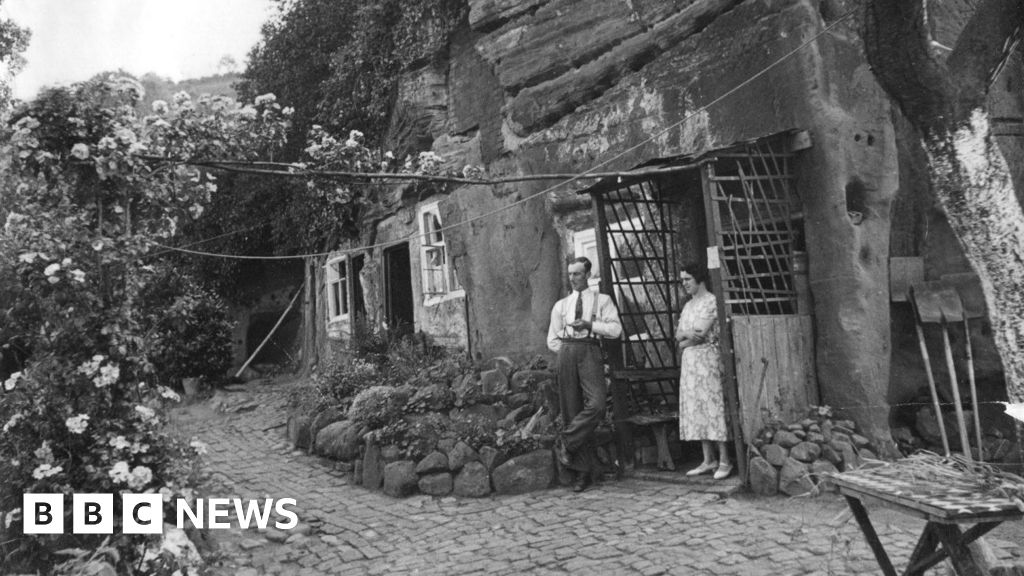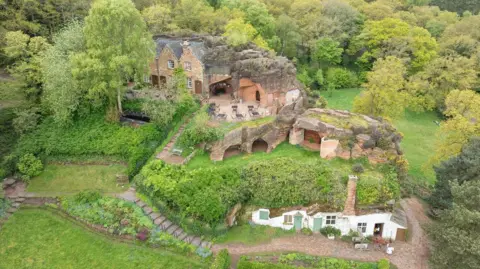
 National Trust
National TrustIt was the middle of the 20th Century when England’s last cave dwellers gave up their homes in a rural part of the country near Birmingham.
Across several centuries, dozens of different families made their home among what began as a couple of sandstone caves in picturesque Kinver Edge, a high heath with views for miles.
Over time, the caves were extended to a series of rock houses, nestled in the Staffordshire countryside, which became a draw for tourists.
At the height of their appeal, hundreds of visitors from across the West Midlands and further afield came across these modern “cave people” before the number of inhabitants dwindled and their rock homes became abandoned.
“They had a much higher quality of life in the rock houses,” said Claire Hale from the National Trust, which looks after the attraction.
“If you were living during the Industrial Revolution, people were exposed to pollution, disease – if you live to reach 50, you were doing well.
“They [in the rock houses] were living into their 80s.”
 National Trust
National TrustThe earliest record of someone living in the caves dates from 1617, although Ms Hale reckoned they could have been used from even earlier.
“Possibly even thousands of years before that as we have an Iron Age hill fort up at the top and potentially people could have taken shelter in them all that way back,” she said.
Due to the softness of the red sandstone, they were easily extended and some grew substantially.
Furniture and stoves were installed and, according to those who visited them, they were warm in winter and cool in summer.
Many had bathtubs and dining areas but residents were often not keen to boast of their homes.
“There was an element of shame living there,” Ms Hale said.
“The families did have jobs. Children did go to school. But it wasn’t something they shouted about. But despite all that, people lived there for a long time.”
 National Trust
National TrustThe rock houses were mentioned again in 1777 when Joseph Heeley, who wrote a traveller’s book, took shelter during a storm.
By the 1861 census, 11 families were listed as living in them.
Many worked as labourers on farms or at the local iron works with others having jobs including as laundry women, boatmen – and one was a local postman.
Rose Novak lived in one until 1956 and told the trust before she died: “Once you got there, it really was nice.
“They were like three separate cottages, two-room cottages.
“There were quarry tiles on the floor, the sitting room had carpet down… the walls were sandstone, plastered over.
“We used to grow everything in the garden. We planted fruit trees, apple and plum and pear. We used to grow all sorts of vegetables, everything.”
 National Trust
National TrustBy the late 19th Century and into the 20th, the rock houses and surrounding landscape were a solid tourist attraction.
“People didn’t used to go on holiday like we do now, they would go away for the day and it would be somewhere that was easily accessible, they would have come to Kinver Edge,” explained Ms Hale.
A tramway run by the Kinver Light Railway started in 1901, taking people from Amblecote, Dudley, into Kinver.
Those living in the rock houses took advantage and set up refreshments.
In an interview with the National Trust before her death, Margaret Handley, born in Kinver in 1911, described how she helped her aunt and uncle with the teas in the 1920s.
“We would see the first people come off [the trams] and this was when they used to get the kettles on for the teas,” she said.
Bill Reeves lived in one of the rock houses and also recalled: “I used to make all the cakes, when I was only 10 or 11 years old.
“I used to stop in on Friday night, come home from school Friday night and that was my night then, making cakes ready for the weekend during the summer.”
 National Trust
National TrustAs cars took off, the tramway service closed.
There was no running water or electricity either, so people began to leave the rock houses for something more modern.
Most families were gone by the 1930s but the last residents left in 1960s, leaving the rock houses to decay.
The National Trust was in the picture from 1917 when a family of landowners gifted them Kinver Edge.
Rock surveys needed
In the 1980s, a committee formed to push for the houses to be saved.
By 1993, the first were restored and further ones followed from 2010.
Ms Hale said they continued to need money to maintain them, including for rock surveys.
But she said visitors were still amazed by the Kinver Rock Houses.
“People refer to them as caves but when you go in, you know, they’re a home, they feel like a home when you’re in there,” she said.
“They’ve got, you know, a range in there to cook from, they’ve got beds, they’ve got furniture, they’ve got windows and doors.”




